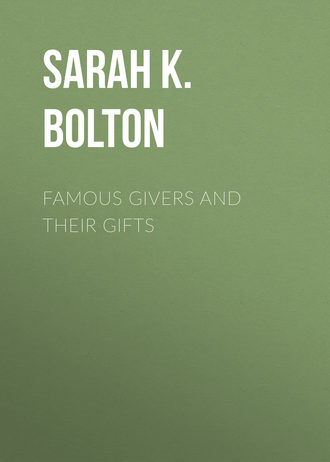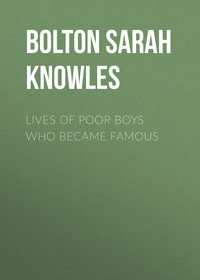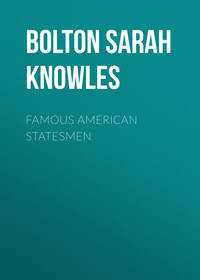 полная версия
полная версияFamous Givers and Their Gifts
In 1719, when on board the ship Sea Flower for Hamburgh, that he might obtain supplies of timber and other naval stores for the royal navy, Captain Coram was stranded off Cuxhaven and his cargo plundered.
Some years later, in 1732, having become much interested in the settlement of Georgia, Captain Coram was appointed one of the trustees by a charter from George II.
Three years after this, in 1735, the energetic Captain Coram addressed a memorial to George II., about the settlement of Nova Scotia, as he had found there "the best cod-fishing of any in the known parts of the world, and the land is well adapted for raising hemp and other naval stores." One hundred laboring men signed this memorial, asking for free passage thither, and protection after reaching Nova Scotia.
Captain Coram was so interested in the project that he appeared on several occasions before the Lords Commissioners for Trade and Plantations, and was, says Horace Walpole, "the most knowing person about the plantations I ever talked with." For several years nothing was done about his memorial, but before his death England took action about her now valuable colony.
About 172 °Captain Coram lived in Rotherhithe, and going often to London early in the morning and returning late at night, became troubled about the infants whom he saw exposed or deserted in the public streets, sometimes dead, or dying, or perhaps murdered to avoid publicity. Sometimes these foundlings, if not deserted, were placed in poor families to whom a small sum was paid for their board; and often they were blinded or maimed as they grew older, and sent on the streets to beg.
The young mother, usually homeless and friendless, was almost as helpless as her child if she tried to keep it and earn a living. People scorned her, or arrested her and threw her into prison: the shipmaster tried to find a remedy for the evil.
He talked with his friends and acquaintances, but no one seemed to care. He besought those high in authority, but few seemed to think that foundlings were worth saving. The poor and the disgraced should bear their sorrows alone. Some from all ranks thought the charity a noble one, and wondered that it had been so long neglected; but none gave a penny, or put forth any effort.
"His arguments," wrote Coram's most intimate friend, Dr. Brocklesby, "moved some, the natural humanity of their own temper more, his firm but generous example most of all; and even people of rank began to be ashamed to see a man's hair become gray in the course of a solicitation by which he was to get nothing. Those who did not enter far enough into the case to compassionate the unhappy infants for whom he was a suitor, could not help pitying him."
Captain Coram finally turned to woman for aid, and obtained the names of "twenty-one ladies of quality and distinction" who were willing to help in his project of a foundling asylum. Not all "ladies of quality" were willing to help, however; for in the Foundling Hospital may be seen this note, attached to a memorial addressed to "H.R.H., the Princess Amelia."
"On Innocents' Day, the 28th December, 1737, I went to St. James' Palace to present this petition, having been advised first to address the lady of the bedchamber in waiting to introduce it. But the Lady Isabella Finch, who was the lady in waiting, gave me rough words, and bid me gone with my petition, which I did, without opportunity of presenting it."
Finally Captain Coram's incessant labors bore fruit. On Tuesday, Nov. 20, 1739, at Somerset House, London, a meeting of the nobility and gentry was held, appointed by his Majesty's royal charter to be governors and guardians of the hospital. Captain Coram, now seventy-one years of age, addressed the president, the Duke of Bedford, with great feeling. "My Lord," he said, "although my declining years will not permit me to hope seeing the full accomplishment of my wishes, yet I can now rest satisfied; and it is what I esteem an ample reward of more than seventeen years' expensive labor and steady application, that I see your Grace at the head of this charitable trust, assisted by so many noble and honorable governors."
The house for the foundlings was opened in Hatton Garden in 1741, no child being received over two months old. No questions as to parentage were to be asked; and when no more infants could be taken in, the sign, "The house is full," was hung over the door. Sometimes one hundred women would be at the door with babies in their arms; and when only twenty could be received, the poor creatures would fight to be first at the door, that their child might find a home. Finally the infants were admitted by ballot, by means of balls drawn by the mothers out of a bag. If they drew a white ball, the child was received; if a black ball, it was turned away.
The present Foundling Hospital was begun in 1740, and the western wing finished and occupied in 1745, on the north side of Guilford Street, London, the governors having bought the land, fifty-five acres, from the Earl of Salisbury.
Hogarth, the painter, was deeply interested in Captain Coram's benevolent object. He painted for the hospital some of his finest pictures, and influenced his brother artists to do the same. Hogarth's "March to Finchley" was intended to be dedicated to George II. A proof print was accordingly presented to the king for his approval. The picture gives "a view of a military march, and the humors and disorders consequent thereon."
The king was indignant, and exclaimed, "Does the fellow mean to laugh at my guards?"
"The picture, please your Majesty," said one of the bystanders, "must be considered as a burlesque."
"What! a painter burlesque a soldier? He deserves to be picketed for his insolence," replied the king.
The picture was returned to the mortified artist, who dedicated it to "the king of Prussia, an encourager of the arts."
So many fine paintings were presented to the hospital, – one of Raphael's cartoons, a picture by Benjamin West, and others, – and such a crowd of people came daily to see them in splendid carriages and gilt sedan chairs, that the institution "became the most fashionable morning lounge in the reign of George II."
This exhibition of pictures of the united artists was the precursor of the Royal Academy, founded in 1768. Before this time the artists had their annual reunion and dinner together at the Foundling Hospital, the children entertaining them with music.
Hogarth, notwithstanding his busy life, requested that several of the infants should be sent to Chiswick, where he resided; and he and Mrs. Hogarth looked carefully after their welfare. It was the custom to send the babies into the country to be nursed by some mother, as soon as they were received at the hospital.
Handel, as well as Hogarth, was interested in the foundlings. The chapel had been erected by subscription in 1847. George II subscribed £2,000 towards its erection, and £1,000 towards supplying a preacher. Handel offered a performance in vocal and instrumental music to raise money in building the chapel. The most distinguished persons in the realm came to hear the music. Over a thousand were present, the tickets being half a guinea each.
Each year, as long as Handel was able to do so, he superintended the performance of his great Oratorio of the Messiah in the chapel, which netted the treasury £7,000. When he died he made the following bequest: "I give a fair copy of the Score, and all the parts of my Oratorio called the Messiah, to the Foundling Hospital."
A singular gift to the hospital was from Omychund, a black merchant of Calcutta, who bequeathed to that and the Magdalen Hospital 37,500 current rupees, to be equally divided between them.
Captain Coram lived ten years after his good work was begun. He loved to visit the hospital, and looked upon the children as if they were his own. He rejoiced in every gift, although he had no money of his own to give. He had buried his wife, Eunice, after whom the first girl at the hospital was named. The first boy was called Thomas Coram, after the founder.
During the last two years of Captain Coram's life, when it was known by his friends that he was without funds, Dr. Brocklesby called to ask him if a subscription in his behalf would offend him. He replied, "I have not wasted the little wealth of which I was formerly possessed in self-indulgence and vain expenses, and am not ashamed to confess that, in this my old age, I am poor."
Mr. Gideon, his friend, obtained various sums from those interested. The late Prince of Wales subscribed twenty guineas yearly.
Captain Coram, content with supplying his barest needs, turned his thoughts to more benevolence. He desired to unite the Indians in North America more closely to British interests, by establishing among them a school for girls. He lived long enough to make some progress in this work, but he was too old to be very active.
He died at his lodgings near Leicester Square, on Friday, March 29, 1751, at the age of eighty-four, his last request being that he might be buried in the chapel of his Foundling Hospital. He was buried there April 3, at the east end of the vault, in a lead coffin enclosed in stone. His funeral was attended by a great concourse of people. The choir of St. Paul's Cathedral, with many notables, were at the hospital to receive the body, and pay it suitable honors. The shipmaster had won renown, not by learning or wealth, but by disinterested benevolence. Seventeen years of patient and persistent labor brought its reward.
In the southern arcade of the chapel one may read a long inscription to the memory of
CAPTAIN THOMAS CORAM,WHOSE NAME WILL NEVER WANT A MONUMENT ASLONG AS THIS HOSPITAL SHALL SUBSISTIn front of the hospital is a fine statue of the founder by William Calder Marshall, R.A.; and within, in the girls' dining-room, is Coram's portrait by Hogarth.
After fifteen years from the time of opening the hospital, the governors, their land having risen in value so that their income was larger, and Parliament having given £10,000, determined that their institution should be carried on in an unrestricted manner, as is the case in Russia and some other countries on the Continent.
In Moscow the Foundling Hospital admits 13,000 children yearly. The mother may reclaim her child at any time before it is ten years of age. The state knows that the child has received a better start in life than it could have done with the poor mother.
The Foundling Asylum at St. Petersburg, established by Catherine the Great, is the largest and finest in the world. The buildings cover twenty-eight acres, and the institution has an annual revenue from the government and from private sources of nearly $5,000,000. Thirteen thousand babies are sometimes brought in one year, who but for this blessed charity would probably have been put out of the way. Twenty-five thousand foundlings are constantly enrolled. In Russia infanticide is said to be almost unknown.
Married people, if poor, may bring their child for one year. If not able to provide for it at the end of that time, then it belongs to the state. The boys become mechanics, or enter the army and navy; and the girls become teachers, nurses, etc.
The Foundling Hospital in London determined to welcome all deserted or destitute infants, and save as many as possible from sin and want. A basket was hung outside the gate of the hospital, and one hundred and seventeen infants were put in it the first day.
Abuses of this kind intention soon crept in. Parents too poor to care for their children sent them from the country to London, and they died often on the way thither. One man, who carried five infants in a basket, got drunk on the journey, lay all night on a common, and three out of the five babies were found dead in the morning. Often the carriers stole all the clothing of the little ones, and they were thrown into the basket naked. Within four years about fifteen thousand babies were received, but only forty-four hundred lived to be sent out into homes. The mothers hated to part with their infants, and would often follow them for miles on foot. The poor mother would leave some token by which her child could be identified. Sometimes it was a coin or a ribbon, or possibly the daintiest cap the poverty of the mother would permit her to make. Sometimes a verse of poetry was pinned on the dress: —
"If Fortune should her favors give,That I in better plight might live,I'd try to have my boy again,And train him up the best of men.""The court-room of the Foundling," says a writer in "Chambers's Journal," "has probably witnessed as painful scenes as any chamber in Great Britain; and again, when the children, at five years old, are brought up to London, and separated from their foster-mothers, these scenes are renewed."
"The stratagems resorted to by women to identify their children," says "Old and New London," "and to assure themselves of their well-being, are often singularly touching. Sometimes notes are found pinned to the infant's garments, beseeching the nurse to tell the mother her name and residence, that the latter may visit the child during its stay in the country. They will also attend the baptism in the chapel, in the hope of hearing the name conferred upon the infant; for, if they succeed in identifying the child during its stay at nurse, they can always preserve its identification during its subsequent abode in the hospital, since the children appear in chapel twice on Sunday, and dine in public on that day, which gives opportunity of seeing them from time to time, and preserving the recollection of their features."
So many children were brought to the hospital after all restrictions were removed, in 1756, the death-roll was so large, and the expenses so great, that after four years different methods were adopted. There are now about five hundred children in the Foundling Hospital, who remain till they are fifteen years old, when they are apprenticed till of age at some kind of labor. None are received at the hospital except when a vacancy occurs, as the size of the buildings and funds will not permit more inmates. Usually about forty are received, one-sixth of those who apply. There is a fund provided to help those in later life who prove idiotic or blind, or unfitted to earn their support.
Sundays visitors in London go often to hear the trained voices of the foundlings. The girls, in their white caps and white kerchiefs, sit on one side of the organ, a gift from the great Handel, and the boys, neatly dressed, on the other side. There is a juvenile band of musicians among the boys; and so well do they play, that, on leaving the institution, they often find positions in the bands of Her Majesty's Household Troops or in the navy. Lieutenant-Colonel James C. Hyde presented the boys with a set of brass instruments, and some valuable drawings of native artists of India, for the adornment of their walls.
Some time ago I visited with much interest the New York Foundling Hospital, on Sixty-eighth Street, six stories high, founded by and in charge of the Sisters of Charity. During the year 1895 there were cared for 3,109 infants and little children, and 516 needy and homeless mothers. On one side of the Foundling Hospital is the Maternity Hospital, and on the other side the Children's Hospital.
The cradle to receive the baby is placed within the vestibule, so that the Sister, when the bell is rung, may talk kindly with the person bringing it, and often persuades her to remain for some months and care for her child. No information is sought as to names, family, etc. Other infants are taken into the country to be nursed by foster-mothers, and the institution does not lose its close oversight of the little ones.
When these infants are unclaimed, they are usually sent to homes in the West to be adopted. Since the opening of the Foundling Hospital in 1869, twenty-six years ago, 27,171 waifs have been received and cared for.
The "Nursery and Child's Hospital," Fifty-first Street and Lexington Avenue, carries on a work similar to the Foundling Asylum, and, though under Protestant control, is not a denominational enterprise.
In Cleveland, Ohio, one of the most interesting charities is the "Lida Baldwin Infants' Rest," for which Mr. H. R. Hatch has given an admirable building, at 1416 Cedar Avenue, costing $17,000 or $18,000. Babies, if over two years old, are taken to the Protestant Orphan Asylum on St. Clair Street. The "Rest" is named after the first wife of Mr. Hatch, an enterprising and philanthropic merchant, who, among other gifts, has just presented a handsome granite library building, costing nearly $100,000, to Adelbert College of Western Reserve University.
When Reuben Runyan Springer died in Cincinnati, Ohio, Dec. 10, 1884, at the age of eighty-four years, he did not forget to give the Sisters of Charity $20,000 for a foundling asylum. His family were originally from Sweden. When a youth he was clerk on a steamboat from Cincinnati to New Orleans, and soon acquired an interest in the boat, and began his fortune. Later, he was partner in a grocery house. Mr. Springer gave to the Little Sisters of the Poor $35,000, Good Samaritan Hospital $30,000, St. Peter's Benevolent Society $50,000, besides many other gifts. To music and art he gave $420,000. To his two faithful domestics and friends, he gave $7,500 each, and to his coachman his horses, carriages, harness, and $5,000. His various charities amounted to a million dollars or more.
Most cities have, or ought to have, a foundling asylum, though often it bears a different name. The Roman Catholics seem to be wiser in this respect, and more careful to save infant life, than we of the Protestant faith.
HENRY SHAW
AND HIS BOTANICAL GARDEN
It is rare that a poor boy comes to America from a foreign land, with almost no money in his pocket, and leaves to his adopted town and State a million four hundred thousand dollars to beautify a city, to elevate its taste, and to help educate its people.
Henry Shaw of St. Louis, Mo., was born in Sheffield, England, July 24, 1800. He was the oldest of four children, having had a brother who died in infancy and two sisters. His father, Joseph Shaw, was a manufacturer of grates, fire-irons, etc., at Sheffield.
The boy obtained his early education at Thorne, a village not far from his native town, and used to get his lessons in an arbor, half hidden by vines, and surrounded by trees and flowers. From childhood he had a passion for a garden, and worked with his two little sisters in planting anemones and buttercups.
From the school at Thorne the lad was transferred to Mill Hill, about twenty miles from London, to a "Dissenting" school, the father being a Baptist. Here he studied for six years, Latin, French, and probably other languages, as he knew in later life German, Italian, and Spanish. He became especially fond of French literature, and in manhood read and wrote French as easily and correctly as English. He was for a long time regarded as the best mathematician in St. Louis.
In 1818, when Henry was eighteen, he and the rest of the family came to Canada. The same year his father sent him to New Orleans to learn how to raise cotton; but the climate did not please him, and he removed to a small French trading-post, called St. Louis, May 3, 1819.
The youth had a little stock of cutlery with him, the capital for which his uncle, Mr. James Hoole, had furnished. His nephew was always grateful for this kind act. He rented a room on the second floor of a building, and cooked, slept, ate, and sold his goods in this one room. He went out very little in the evening, preferring to read books, and sometimes played chess with a friend. It is thought that he rather avoided meeting young ladies, as he perhaps naturally preferred to marry an English girl, when able to support her; but when the fortune was earned he was wedded to his gardens, his flowers, and his books, so that he never married. The young man showed great energy in his hardware business, was very economical, honest, and always punctual. He had little patience with persons who were not prompt, and failed to keep an engagement.
Though usually self-poised, possessing almost perfect control over a naturally quick temper, a gentleman relates that he once saw him angry because a man failed to keep an appointment; but Mr. Shaw regretted that he had allowed himself to speak sharply, and asked the offending person to dine with him. His head-gardener, Mr. James Gurney, from the Royal Botanical Garden in Regent's Park, London, said many years ago of Mr. Shaw, "In twenty-three years I never heard him speak a harsh or an irritable word. No matter what went wrong, – and on such a place, and with so many men, things will go wrong occasionally, – he was always pleasant and cheerful, making the best of what could not be helped."
Mr. Shaw gave close attention to business in the growing town of St. Louis, and in 1839, after he had been there twenty years, was astonished to find that his annual profits were $25,000. He said, "this was more money than any man in my circumstances ought to make in a single year;" and he resolved to go out of business as soon as a good opportunity presented itself. This occurred the following year, in 1840; and at forty years of age, Mr. Shaw retired from business with a fortune of $250,000, equivalent to a million, probably, at the present day.
After twenty years of constant labor he determined to take a little rest and change. In September, 1840, he went to Europe, stopping in Rochester, N.Y., where his parents and sisters then resided, and took his younger sister with him.
He was absent two years, and coming home in 1842, soon arranged for another term of travel abroad. He remained in Europe three years, travelling in almost all places of interest, including Constantinople and Egypt. He kept journals, and wrote letters to friends, showing careful observation and wide reading. He made a third and last visit to Europe in 1851, to attend the first World's Fair, held in London. During this visit he conceived the plan of what eventually became his great gift. While walking through the beautiful grounds of Chatsworth, the magnificent home of the Duke of Devonshire, Mr. Shaw said to himself, "Why may not I have a garden too? I have enough land and money for something of the same sort in a smaller way."
The old love for flowers and trees, as in boyhood, made the man in middle life determine to plant not so much for himself as for posterity. He had finished a home in the suburbs of St. Louis, Tower Grove, in 1849; and another was in process of building in the city on the corner of Seventh and Locust Streets, when Mr. Shaw returned from Europe in 1851.
For five or six years he beautified the grounds of his country home, and in 1857 commissioned Dr. Engelmann, then in Europe, to examine botanical gardens and select proper books for a botanical library. Correspondence was begun with Sir William J. Hooker, the distinguished director of the famous Kew Gardens in London, our own beloved botanist, Professor Asa Gray of Harvard College, and others. Dr. Engelmann urged Mr. Shaw to purchase the large herbarium of the then recently deceased Professor Bernhardi of Erfurt, Germany, which was done, Hooker writing, "The State ought to feel that it owes you much for so much public spirit, and so well directed."
March 14, 1859, Mr. Shaw secured from the State Legislature an Act enabling him to convey to trustees seven hundred and sixty acres of land, "in trust, upon a portion thereof to keep up, maintain, and establish a botanic garden for the cultivation and propagation of plants, flowers, fruit and forest trees, and for the dissemination of the knowledge thereof among men, by having a collection thereof easily accessible; and the remaining portion to be used for the purpose of maintaining a perpetual fund for the support and maintenance of said garden, its care and increase, and the museum, library, and instruction connected therewith."
For the next twenty-five years Mr. Shaw gave his time and strength to the development of his cherished garden and park. "He lived for them," says Mr. Thomas Dimmock, "and, as far as was practicable, in them; walking or driving every day, when weather and health allowed, and permitting no work of importance to go on without more or less of his personal inspection and direction. The late Dr. Asa Gray, than whom there can be no higher authority, once said, 'This park and the Botanical Garden are the finest institutions of the kind in the country; in variety of foliage the park is unequalled.'"






